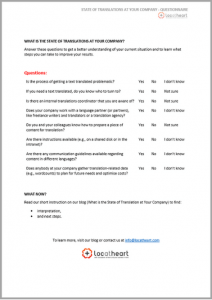What’s the state of translations at your company?
Understand your current situation to improve your results. What results?
Translation efficiency and smoothness, of course!
Ask yourself:
- Is the process of getting a text translated problematic?
- If you need a text translated, do you know who to turn to?
- Is there an internal translations coordinator that you are aware of?
- and 5 more questions!
State of Translations at Your Company – questionnaire:
Now let’s take a closer look.
Evaluate your translation process:
The first question alone lets you gain valuable insights.
1. Is the process of getting a text translated problematic?
At companies that have an established translation process, translating something is not a problem. You just turn to a simple procedure.
If there is no such procedure, however, translation is often seen as a nuisance. If you must blaze the trail every single time, lots of time is wasted. This kind of situation may also lead to procrastination and delays (e.g. in publication).
Questions 2–4 are related to the structural frame of the process.
2. If you need a text translated, do you know who to turn to?
3. Is there an internal translations coordinator that you are aware of?
4. Does your company work with a language partner (or partners), like freelance writers and translators or a translation agency?
Some companies use a partial structure – they may work with partners, but lack an internal coordination system. Having just one element is better than not having any, but note that the respective stages of the process must always be adjusted to the company, its capabilities and needs.
Questions 5–7 focus on the quality of translation.
5. Do you and your colleagues know how to prepare a piece of content for translation?
6. Are there instructions available (e.g. on a shared disk or in the intranet)?
7. Are there any communication guidelines available regarding content in different languages?
The preparation of files and briefs as well as the existence of guidelines are all factors leading to high-quality translation and communication. They also make the translation process shorter and more efficient. Some companies do have guidelines but don’t distribute them among employees. Others distribute instructions regarding file preparation but not regarding language. Once you determine which elements are in place and which are not, you can find areas for improvement.
The final question is related to cost optimisation.
8. Does anybody at your company gather translation-related data (e.g. wordcounts) to plan for future needs and optimise costs?
In many companies, each vertical or each brand works with the language service providers of their choice. This freedom may sometimes be valuable – particularly when the selected partners are specialists in their respective fields (e.g. a different provider for legal content, and a different one for marketing texts). But having too many partners may hinder your company from taking advantage of economies of scale.
It is important to look at the scale and structure of translations at your company every now and then to assess cost-effectiveness and plan resources according to actual needs.
Next steps
Now that you have your answers and know what they mean, you can draw conclusions about the state of translations at your company.
- Which areas need improvement?
- Which improvements can be introduced with little effort?
- Which solutions will have real impact on the efficiency of your work?
Discuss these questions with your team!








Leave a Reply